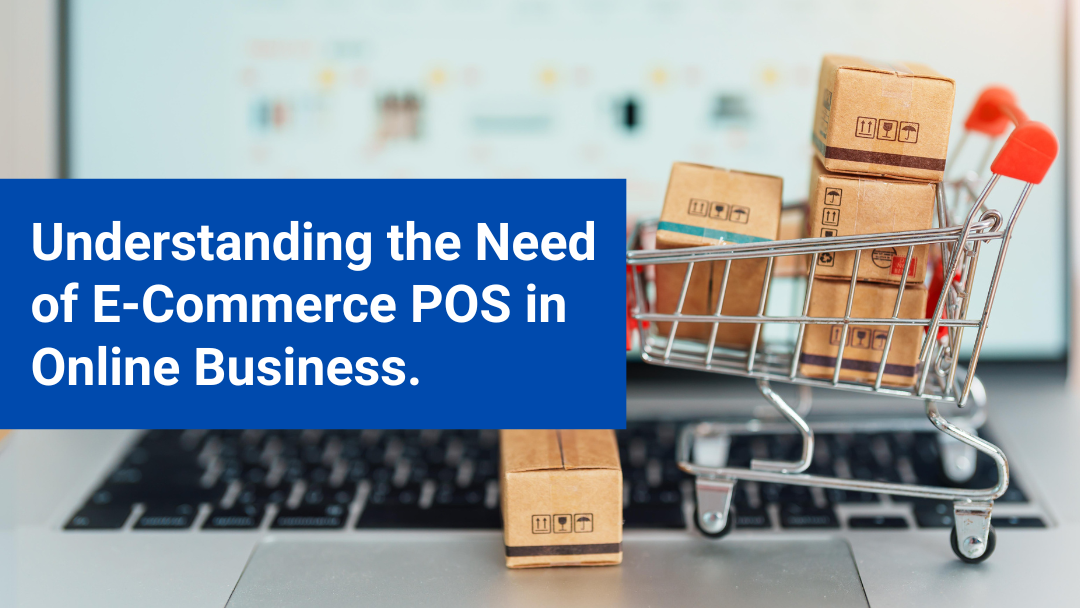Understanding the Need of E-Commerce POS in Online Business.
Are you skeptical about incorporating a POS system in your e-commerce business? If yes, this well-researched article will clear all your doubts and help you invest in the right POS system for your business.
What is an e-commerce POS system?
An e-commerce POS (Point of Sale) system is a software solution that allows online businesses to manage sales, inventory, customer data, and transactions. While traditional POS systems are used in physical stores, an e-commerce POS is tailored for online sales, integrating with online storefronts to handle the various aspects of digital transactions.
Key features of the e-commerce POS system:
1) Order Management: Tracks online orders from purchase to delivery, ensuring smooth processing.
2) Inventory Management: Automatically updates inventory levels based on online sales, helping prevent stockouts or overselling.
3) Payment Processing: Handles secure payment transactions, supporting various payment methods like credit/debit cards, digital wallets, and even cryptocurrencies.
4) Customer Management: Stores customer information, including purchase history, preferences, and contact details, aiding in personalized marketing and customer service.
5) Sales Reporting and Analytics: Provides insights into sales performance, customer behavior, and inventory levels, enabling better business decisions.
6) Integration with Other Systems: Often integrates with other e-commerce platforms, shipping software, and accounting systems to create a seamless workflow.
Why e-commerce business need a POS system?
POS (Point of Sale) systems play a crucial role in boosting e-commerce businesses by streamlining operations, enhancing customer experiences, and providing valuable insights. Here’s how POS systems contribute to the growth and success of an e-commerce business:
1) Streamlining Operations:
- Unified Management: A POS system integrates different aspects of the business, such as inventory, orders, payments, and customer data, into a single platform. This reduces the complexity of managing multiple systems and ensures that all parts of the business work together seamlessly.
- Automated Inventory Management: POS systems automatically update inventory levels in real-time as sales are made. This prevents issues like stockouts and overselling, ensuring that the business can meet customer demand without interruption.
- Efficient Order Processing: By automating order management, POS systems help businesses process orders more quickly and accurately. This leads to faster fulfillment and shipping, which is critical for customer satisfaction.
2) Enhancing Customer Experience:
- Personalized Marketing: With customer data stored in the POS system, businesses can tailor marketing efforts to individual preferences and purchase histories. Personalized promotions and recommendations can increase customer loyalty and drive repeat purchases.
- Multi-Channel Consistency: POS systems often support both online and offline sales channels, ensuring a consistent customer experience regardless of how they shop. This is especially important for businesses that operate both an e-commerce site and physical stores.
- Simplified Checkout Process: A streamlined and secure checkout process provided by a POS system reduces cart abandonment rates and improves conversion rates. The system can offer multiple payment options and save customer preferences for faster future transactions.
3) Providing Business Insights:
- Sales and Performance Analytics: POS systems generate detailed reports on sales, customer behavior, and inventory. These insights help businesses understand what’s working and what needs improvement, allowing for data-driven decisions.
- Trend Identification: By analyzing sales data over time, POS systems can help identify trends and seasonal patterns. This allows businesses to anticipate demand, adjust inventory, and optimize pricing strategies.
- Employee Performance Tracking: For businesses with staff, POS systems can track employee sales performance, helping to identify top performers and areas where additional training might be needed.
4) Supporting Growth and Scalability:
- Scalability: As the business grows, a POS system can easily scale to handle increased transaction volumes, more products, and additional sales channels. This flexibility is essential for businesses that are expanding their reach.
- Integration with Other Systems: POS systems often integrate with other e-commerce tools like CRM, accounting software, and shipping platforms, creating a cohesive ecosystem that supports business growth.
5) Security and Compliance:
- Secure Transactions: POS systems ensure that customer payment data is handled securely, reducing the risk of fraud and chargebacks. Compliance with standards like PCI DSS (Payment Card Industry Data Security Standard) is often built into these systems.
- Data Protection: POS systems help businesses comply with data protection regulations by securely storing customer information and providing tools for data management.
Key points to consider for choosing the right POS system for your e-commerce business:
Choosing the right POS (Point of Sale) system for your e-commerce business ensures smooth operations, enhances customer experience, and supports growth. Here are the key points to consider when selecting a POS system:
1) Integration Capabilities:
- E-commerce Platform Compatibility: Ensure the POS system integrates seamlessly with your e-commerce platform (e.g., Shopify, WooCommerce, Magento). This ensures that data flows smoothly between your online store and the POS system.
- Third-Party Integrations: Check for compatibility with other essential tools like accounting software, CRM systems, payment gateways, and inventory management solutions.
2) Inventory Management:
- Real-Time Inventory Tracking: The POS system should offer real-time inventory updates to avoid stockouts and overselling. It should also allow you to track inventory across multiple locations if needed.
- Inventory Alerts and Reports: Look for features that provide low-stock alerts and detailed inventory reports, helping you manage stock levels efficiently.
3) User-Friendliness:
- Ease of Use: The system should be intuitive and easy to use for both you and your employees, minimizing the learning curve and reducing the likelihood of errors.
- Customer Support and Training: Consider the availability and quality of customer support, as well as training resources to help you and your team get the most out of the system.
4) Payment Processing:
- Payment Methods Supported: Ensure the POS system supports multiple payment methods, including credit/debit cards, digital wallets (e.g., PayPal, Apple Pay), and alternative payment options (e.g., buy now, pay later).
- Transaction Fees: Review the transaction fees associated with the POS system’s payment processing to ensure they are competitive and won’t significantly impact your profit margins.
- Security Compliance: Check that the system complies with security standards like PCI DSS (Payment Card Industry Data Security Standard) to protect customer data.
5) Scalability and Flexibility:
- Scalability: Choose a POS system that can grow with your business, handling increased sales volumes, more products, and additional sales channels as needed.
- Customization: The system should offer customization options to tailor it to your specific business needs, including personalized reports, customer engagement tools, and more.
6) Customer Management Features:
- Customer Data Collection: The POS system should allow you to collect and store customer data, including purchase history and contact information, to enhance marketing and customer service efforts.
- Loyalty Programs and Promotions: Look for features that support loyalty programs, discounts, and personalized promotions to encourage repeat business.
7) Reporting and Analytics:
- Sales Reporting: The system should provide comprehensive sales reports, including daily, weekly, and monthly summaries, as well as product-specific performance insights.
- Customer Insights: Analytics on customer behavior, such as purchasing patterns and preferences, can help you refine your marketing strategies and improve customer retention.
- Inventory and Employee Performance Reports: Reports on inventory turnover and employee sales performance can help optimize stock levels and improve staff efficiency.
8) Pricing Structure:
- Upfront Costs vs. Subscription Fees: Consider whether the system requires a one-time purchase or a subscription model. Factor in the long-term costs and whether they fit within your budget.
- Additional Costs: Be aware of any additional costs, such as transaction fees, hardware expenses, or fees for additional features or integrations.
9) Multi-Channel Capabilities:
- Unified Commerce: If you operate both online and offline channels, the POS system should unify these channels, providing a consistent customer experience and centralized management of sales, inventory, and customer data.
- Omni-Channel Support: Look for features that allow you to sell across various channels (e.g., online store, mobile app, social media) and manage all transactions from a single dashboard.
10) Mobile Accessibility:
- Mobile POS (mPOS) Options: Consider whether the system offers mobile POS capabilities, allowing you to manage sales and inventory on the go, which can be especially useful for pop-up shops or events.
- Cloud-Based Access: A cloud-based POS system enables you to access your business data from any location with an internet connection, offering greater flexibility.
11) Hardware Requirements:
- Compatibility with Existing Hardware: Check if the POS system is compatible with your current hardware, such as barcode scanners, receipt printers, and card readers, or if new hardware will be required.
- Future-Proof Hardware Options: Consider whether the hardware can support future upgrades or expansions, ensuring longevity and value for your investment.
12) Reviews and Recommendations:
- User Reviews: Research user reviews and testimonials to gauge the experiences of other businesses similar to yours. This can provide insights into the system’s reliability and performance in real-world scenarios.
- Industry Recommendations: Look for POS systems that are well-regarded within your industry, as they are more likely to have features tailored to your specific business needs.
SUMMING UP
A robust POS system is integral to the success of an e-commerce business. It not only streamlines day-to-day operations but also enhances customer experiences, provides valuable insights for strategic decisions, and supports business growth. Further, choosing the right POS system involves careful consideration of various factors that affect both your day-to-day operations and long-term business goals.
By leveraging a POS system, e-commerce businesses can operate more efficiently, improve customer satisfaction, and ultimately boost sales and profitability.

